Meltdown & Spectre: Analyzing Performance Impacts on Intel's NUC7i7BNH
by Ganesh T S on March 23, 2018 4:15 PM EST- Posted in
- Systems
- Spectre
- Benchmarks
- Meltdown
BAPCo and Futuremark Benchmarks
BAPCo's SYSmark 2014 SE is an application-based benchmark that uses real-world applications to replay usage patterns of business users in the areas of office productivity, media creation and data/financial analysis. In addition, it also addresses the responsiveness aspect which deals with user experience as related to application and file launches, multi-tasking etc. Scores are meant to be compared against a reference desktop (the SYSmark 2014 SE calibration system in the graphs below). While the SYSmark 2014 benchmark used a Haswell-based desktop configuration, the SYSmark 2014 SE makes the move to a Lenovo ThinkCenter M800 (Intel Core i3-6100, 4GB RAM and a 256GB SATA SSD). The calibration system scores 1000 in each of the scenarios. A score of, say, 2000, would imply that the system under test is twice as fast as the reference system.
We see that the patching does have an impact on the performance. It ranges from around 5% for the Office Productivity scenario to around 10% for the Responsiveness metric.

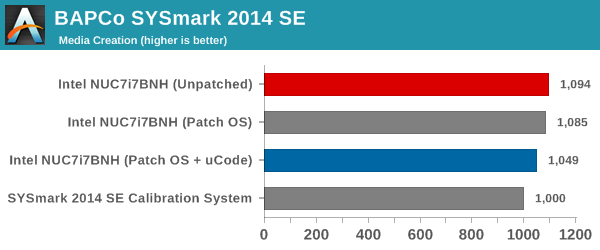

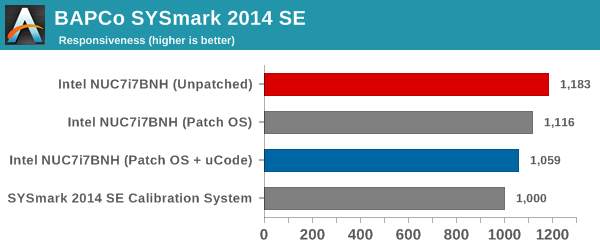
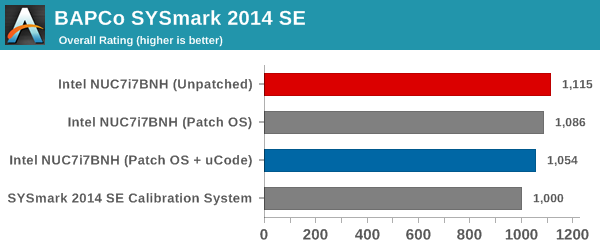
SYSmark 2014 SE also adds energy measurement to the mix. We see that the patched system, despite being slower, consumes lower energy for the completion of the tasks.
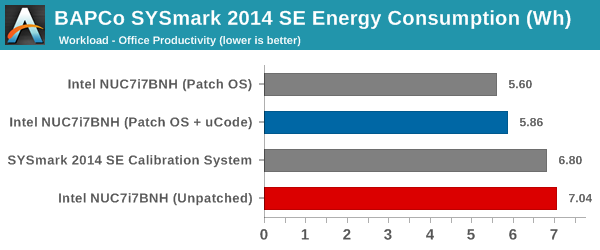
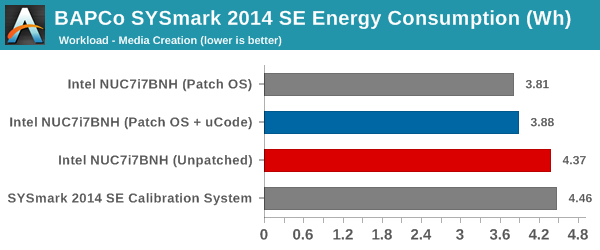
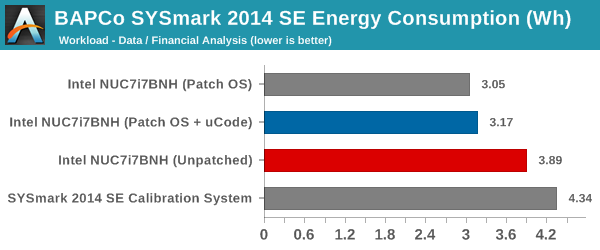
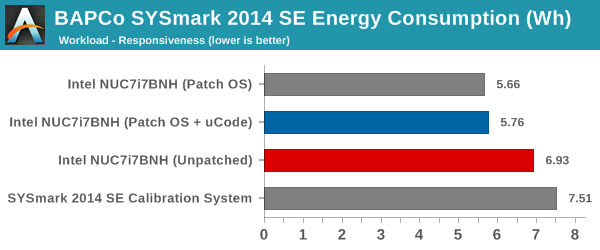

Futuremark PCMark 10
UL's PCMark 10 evaluates computing systems for various usage scenarios (generic / essential tasks such as web browsing and starting up applications, productivity tasks such as editing spreadsheets and documents, gaming, and digital content creation). We benchmarked the configurations with the PCMark 10 Extended profile and recorded the scores for various scenarios. These scores are heavily influenced by the CPU and GPU in the system, though the RAM and storage device also play a part. The power plan was set to Balanced for all the PCs while processing the PCMark 10 benchmark.
Similar to SYSmark 2014 SE, we see performance impacts in all the PCMark 10 scenarios also. For example, the Essentials workload score for the fully patched system is around 6.5% lower than the unpatched system. The gaming workload doesn't seem to be affected much by the patching, though. The overall score is around 2.3% lower.





Futuremark PCMark 8
We continue to present PCMark 8 benchmark results (as those have more comparison points) while our PCMark 10 scores database for systems grows in size. PCMark 8 provides various usage scenarios (home, creative and work) and offers ways to benchmark both baseline (CPU-only) as well as OpenCL accelerated (CPU + GPU) performance. We benchmarked select PCs for the OpenCL accelerated performance in all three usage scenarios. Since these scores are heavily influenced by the CPU in the system, it is not surprising to see a performance impact. The patched configuration, on average, scores around 2% lower than the unpatched one.



Miscellaneous Futuremark Benchmarks

PCMark 7's PCMark Suite shows a 4% performance loss.

3DMark 11's entry level score and 3DMark 2013's Cloud Gate score actually end up better after the patch, but, 3DMark 2013's Ice Storm score shows a performance loss of more than 13%.


Futuremark PCMark 8 Storage Bench
PCMark 8 has a storage bench where certain common workloads such as loading games and document processing are replayed on the target drive. Results are presented in two forms, one being a benchmark number and the other, a bandwidth figure. We ran the PCMark 8 storage bench on the ADATA NVMe SSD in all the configurations.


While the absolute score is just around 1.3% lower for the patched configuration, the storage bandwidth is around 29% worse. This significant performance loss is partly due to the NVMe drive performance now being CPU bound. It is highly likely that SATA drives will not experience such a drastic performance loss due to the patching.










83 Comments
View All Comments
Samus - Saturday, March 24, 2018 - link
It isn't a bug, or a design flaw. It's just an exploit of the architecture.Saying otherwise is like saying houses not built for category 3 hurricanes in New York have a design flaw when the area has never needed construction to that spec. But with climate change, the need is becoming necessary as the architecture is no longer fit for the climate.
Not a great analogy, but in the same example, neither Intel nor construction designers anticipated the architecture would become flawed due to unforeseen circumstances.
Alexvrb - Saturday, March 24, 2018 - link
It's definitely a flaw. Unintentional security flaws are still flaws. It's an exploit of a security flaw in the architecture. They'll release a CPU in the future which still have speculative execution and isn't vulnerable to this flaw, at an architecture level. It might have other flaws, however. CPU flaws, bugs, errata are very common.HStewart - Saturday, March 24, 2018 - link
"It isn't a bug, or a design flaw. It's just an exploit of the architecture."It is attempt to distract on Intel productions, that also back fire because it also effects ARM and AMD.
bji - Sunday, March 25, 2018 - link
That's not really true. There is a class of very hard to exploit design flaws in most implementations of speculative execution that seem to be systemic to almost all chips, that is true. These are so hard to exploit as to be nearly unexploitable in my opinion. These are called Spectre.But there is also a much more significant and easy to exploit design flaw. This affects only Intel chips (and I guess some ARM chips too -- but not AMD). This is called Meltdown.
So there is no distracting going on here. Almost all chips are affected by spectre, but it's so hard to exploit as to almost be irrelevant. Meltdown is serious and it's Intel only.
Manch - Monday, March 26, 2018 - link
HStewart is an Intel shill/fan boy. In his mind Intel can do no wrong. You're wasting your breath arguing with him.bcronce - Sunday, March 25, 2018 - link
A bug is when something does not work to spec.boozed - Sunday, March 25, 2018 - link
I bet you $10 the spec doesn't say "our branch prediction should have this massive security flaw".linuxgeex - Monday, March 26, 2018 - link
Correct, it's a design flaw not a bug. When something operates as designed it isn't a bug, but that doesn't make it correct either. Intel is rightly getting sued by the people who are significantly affected and who can afford to battle Intel in court... that will be people who forked over millions to obtain small performance improvements based on Intel's claims of security, performance, and fitness for the purpose for which it was sold, which later was found to be false. They are being sued exactly the same way that Honda would be sued if they supplied a Formula One team with an engine that performed 30% slower than advertised.Alexvrb - Saturday, March 24, 2018 - link
It's a CPU vulnerability.willis936 - Friday, March 23, 2018 - link
The power consumption drop with performance is interesting. I'd be interested in seeing a comparison of efficiency pre and post patch. At a glance t's difficult to tell if efficiency has gone up, down, or stayed the same. I'm under the impression that this patch disables speculative execution entirely which, unless speculation takes a lot more power than I think, efficiency should go down.